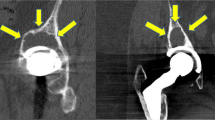Summary
One hundred and eighty-one cementless total hip arthroplasties with threaded polyethylene acetabular components, carried out between 1980 and 1981, have been reviewed retrospectively. Discrepancy between the complaints of the patients with loose components and destruction of acetabular bone led to the development of a four stage radiological grading system which would enable loosening to be anticipated in routine cases. There was a high percentage of loosening (33%) in our series and direct bone-polyethylene contact gave rise to severe granulomatous reactions around the implants. Strict radiological follow up and early revision surgery is indicated in this type of arthroplasty.
Résumé
Les auteurs ont revu, de façon rétrospective, une série de 181 arthroplasties totales de hanche avec cotyles vissés de polyéthylène, non cimentés. Les opérations avaient été faites entre 1980 et 1981. Des discordances entre la symptomatologie clinique et la perte de stabilité des pièces prothétiques ainsi qu'avec l'usure du stock osseux cotyloïdien, ont conduit à définir des critères radiologiques qui permettent de prévoir l'instabilité lors des contrôles systématiques. Une classification en 4 degrés a été établie en se basant sur des critères radiologiques (sclérose, perte de contact entre l'os et le filetage de polyéthylène, liseré autour de la cupule, géodes d'ostéolyse à distance de la pièce cotyloïdienne, modification de la position de l'implant, ostéolyse de l'extrémité supérieure du fémur). La revue a révélé un pourcentage élevé de lâchage des pièces cotyloïdiennes (33%). Le contact direct entre os et polyéthylène entraîne de graves lésions granulomateuses autour des implants. Une surveillance radiologique rigoureuse et une révision chirurgicale précoce sont recommandées dans les arthroplasties totales de hanche avec cotyle vissé en polyéthylène.
Similar content being viewed by others
References
Bertin KC, Freeman MAR, Morscher E (1985) Cementless acetabular replacement using a pegged polyethylene prosthesis. Arch Orth Trauma Surg 104: 251
De Lee JG, Charnley J (1976) Radiological demarcation of cemented sockets in total hip replacement. Clin Orthop 121: 20
Egli A, Weber BG, Sieber H, Semlitsch M, Dörre E (1986) Erfahrungen mit der Gleitpaarung Polyäthylen/Keramik bei Hüft-Endoprothesen. Symposium UHMWPE als Biomaterial, Göttingen
Endler M (1982) Theoretisch-experimentelle Grundlagen und erste klinische Erfahrung mit einer neuen zementfreien Polyäthylenschraubpfanne beim Hüftgelenkersatz. Acta Chir Austr Suppl 45: 3
Endler M, Endler F (1986) Zementfreier Hüftpfannenersatz mit einer konischen Polyäthylenschraubpfanne. Med Orthop Technik 1: 2
Eyerer P (1985) Histological results with cementfree implanted hip joint sockets of polyethylene. Arch Orth Trauma Surg 103: 145
Goldring SR, Schiller AL, Roelke M, Rourke CM, O'Neill DA, Harris WH (1983) The synovial like membrane at the bone cement interface in loose total hip replacement and its proposed role in bone lysis. J Bone Joint Surg [Am] 65: 575
Gruen TA, McNeice GM, Amstutz HC (1979) Modes of Failure of cemented stem type femoral components. Clin Orthop 141: 17
Harris WH, Schiller AL, Scholler JM, Freiberg RA, Scott R (1976) Extensive localized bone resorption in the femur following total hip replacement. J Bone Joint Surg [Am] 58: 612
Jones LC, Hungerford DS (1987) Cement disease. Clin Orthop 225: 192
Lintner F, Böhm G, Bösch P, Brand G, Endler M, Zweymüller K (1986) Ergebnisse histologischer und mikroradiographischer Untersuchungen an zementlos implantierten Polyäthylen-Schraubpfannen. Kongressband, Symposium “UHMWPE als Biomaterial”, Göttingen
Lintner F, Böhm G, Brand G, Endler M, Zweymüller K (1988) Ist hoch dichtes Polyäthylen als Implantationsmaterial zur zementfreien Verankerung von Hüftendoprothesen geeignet? Eine histomorphologische Untersuchung an explantierten Polyäthylenschraubpfannen. Z Orthop 126: 688
Morscher E, Dick W, Kernen V (1982) Cementless fixation of polyethylene acetabular component in total hip arthroplasty. Arch Orth Trauma Surg 99: 223
Morscher E, Schmassmann A (1983) Failures of total hip arthroplasty and probable incidence of revision surgery in the future. Arch Orth Trauma Surg 101: 137
Morscher E (1989) Endoprosthetic surgery in 1988. Ann Chir Gyn 78: 242
Remagen W, Morscher E (1984) Histological results with cement-free implanted hip joint sockets of polyethylene. Arch Orth Trauma Surg 103: 145
Russe W, Tschupic P (1986) Wanderung der isoelastischen RM Pfanne. Symposium UHMWPE als Biomaterial, Göttingen
Santavirta S, Hoikka V, Eskola A, Konttinen YT, Paavilainen T, Tallroth K (1990) Aggressive granulomatous lesions in cementless total hip arthroplasty. J Bone Joint Surg [Br] 72: 980
Scott WW, Riley LJ, Dorfman HD (1985) Focal lytic lesions associated with femoral stem loosening in total hip prosthesis. Am J Roentgenology 144: 977
Semlitsch M, Lehmann M, Dörre E, Willert HG (1976) Neue Perspektiven zur verlängerten Funktionsdauer künstlicher Hüftgelenke durch Werkstoffkombination Polyäthylen — Aluminium — Hydroxidkeramik — Metall. Med Orth Technik 96: 152
Semlitsch M (1990) Stand der Werkstofftechnik des Zweymüller-Hüftprothesensystems nach 10 Jahren klinischer Praxis. In: K. Zweymüller (Hrg), 10 Jahre Zweymüller Hüftendoprothese, 1. Aufl. Hans Huber, Bern
Skripitz W (1985) Zur Implantation der Endler Pfanne bei Dysplasiecoxarthrose. Aktueller Stand der zementfreien Hüftendoprothetik. Symposium, Düsseldorf
Skripitz W, Gödel B (1988) Zur Problematik gelockerter zementloser Schraubpfannen nach Endler. Orthop Praxis 4: 246
Streicher RM (1986) Ultrahochmolekulares Polyäthylen als Werkstoff für Hüftgelenkspfannen. In: Der alloplastische Ersatz der Hüftpfanne. Thieme, Stuttgart
Weber BG (1981) Total hip replacement, rotating versus fixed and metal versus ceramic heads. Proc 9th Hip Soc Meeting, p 264
Zweymüller K, Semlitsch M (1982) Concepts and material properties of a cementless hip prosthesis system with AI2 O3 ceramic ball heads and wrought Ti-6A1–4V stems. Arch Orthop Trauma Surg 100: 229
Author information
Authors and Affiliations
Rights and permissions
About this article
Cite this article
Krugluger, J., Eyb, R. Bone reaction to uncemented threaded polyethylene acetabular components. International Orthopaedics 17, 259–265 (1993). https://doi.org/10.1007/BF00194192
Issue Date:
DOI: https://doi.org/10.1007/BF00194192




